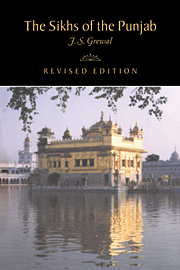Book contents
- Frontmatter
- Introduction
- 1 The Turko-Afghan Rule
- 2 Foundation of the Sikh Panth
- 3 Evolution of the Sikh Panth (1539–1606)
- 4 Transformation of the Sikh Panth (1606–1708)
- 5 Rise to political power (1708–1799)
- 6 The Sikh empire (1799–1849)
- 7 Recession and resurgence (1849–1919)
- 8 In the struggle for freedom (1920–1947)
- 9 Towards the ‘Punjabi Province’ (1947–1966)
- 10 In the new Punjab state (1966–1984)
- Bibliographical essay
- Index
- THE NEW CAMBRIDGE HISTORY OF INDIA
2 - Foundation of the Sikh Panth
Published online by Cambridge University Press: 28 March 2008
- Frontmatter
- Introduction
- 1 The Turko-Afghan Rule
- 2 Foundation of the Sikh Panth
- 3 Evolution of the Sikh Panth (1539–1606)
- 4 Transformation of the Sikh Panth (1606–1708)
- 5 Rise to political power (1708–1799)
- 6 The Sikh empire (1799–1849)
- 7 Recession and resurgence (1849–1919)
- 8 In the struggle for freedom (1920–1947)
- 9 Towards the ‘Punjabi Province’ (1947–1966)
- 10 In the new Punjab state (1966–1984)
- Bibliographical essay
- Index
- THE NEW CAMBRIDGE HISTORY OF INDIA
Summary
A rigorous analysis of the compositions of Guru Nanak reveals that there is hardly anything in contemporary politics, society or religion that he finds commendable. Yet the age of Guru Nanak was not fundamentally or even radically different from the previous or the following few centuries. Much of his denunciation, therefore, can be understood in terms of his moral fervour. For a rational conceptualization of his position it may be suggested that the entire social order had lost its legitimacy in the eyes of Guru Nanak because it had lost its support from the prevalent religious ideologies: it was neither ‘Hindu’ nor ‘Muslim’. A new religious ideology was needed to become the basis of a new social order. At one stage in his life Guru Nanak came to believe that he had discovered a new ideology and he was looking at the contemporary situation from the standpoint of this new ideology. His denunciation of contemporary practices and beliefs is only an inverted statement of his positive ideals.
Guru Nanak was thoroughly familiar with the politico-administrative arrangements made by the Afghan rulers, particularly in the Punjab. This familiarity, reflected in the use of his metaphors, is a measure of his preoccupation with this vital aspect of the social situation. Moreover, there is direct denunciation of contemporary rule. The rulers are unjust; they discriminate against their non-Muslim subjects by extorting jizya and pilgrimage tax. The ruling class is oppressing the cultivators and the common people.
- Type
- Chapter
- Information
- The Sikhs of the Punjab , pp. 28 - 41Publisher: Cambridge University PressPrint publication year: 1991

